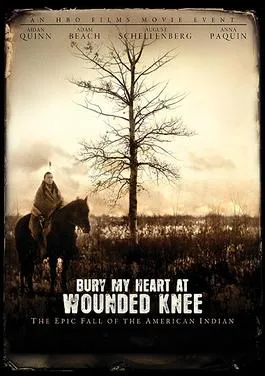Historical accuracy of Bury My Heart at Wounded Knee

Historical accuracy of Bury My Heart at Wounded Knee

Characters
Charles Eastman (Ohiyesa) (Adam Beach)
A real historical figure, but his role is significantly expanded and dramatized for the film. He serves as a primary viewpoint character, connecting events where he wasn't historically central (e.g., depicted at Little Bighorn as a boy, which is inaccurate).
Sitting Bull (August Schellenberg)
Portrayed as a proud, resistant leader facing immense pressure. His portrayal captures his historical stance and tragic end, generally considered nuanced and accurate within the film's scope.
Henry L. Dawes (Aidan Quinn)
Portrayed as a well-intentioned assimilationist whose policies ultimately proved devastating for Native American tribal structures and land ownership, which aligns with historical interpretations of his impact.
Red Cloud (Gordon Tootoosis)
Depicted accurately as a prominent chief who had already transitioned to reservation life, representing a path of negotiation and accommodation compared to Sitting Bull's resistance.
Elaine Goodale Eastman (Anna Paquin)
A real historical figure known for her work with the Sioux and marriage to Charles Eastman. Her presence and advocacy are accurately based on her life.
Colonel Nelson A. Miles (Shaun Johnston)
A real military figure involved in the Plains Wars. His interactions and attitudes shown in the film reflect his historical role.
More characters
General William T. Sherman (Colm Feore)
Represents the military leadership enforcing government policy towards Native Americans during the era.
President Ulysses S. Grant (Fred Thompson)
Represents the U.S. government leadership involved in setting policy and treaties (often broken) with Native tribes.
James McLaughlin (J.K. Simmons)
The actual agent at Standing Rock agency whose actions, under government orders, led directly to the attempt to arrest Sitting Bull. Portrayed unsympathetically, reflecting historical accounts.
Story
Aftermath of Little Bighorn (1876)
Accurately sets the stage for increased U.S. government pressure and military action to force remaining Lakota Sioux onto reservations following Custer's defeat.
Implementation and Impact of the Dawes Act (1887)
The film correctly portrays the Act's aim to break up communal land ownership in favor of individual allotments (assimilation) and its devastating result: massive loss of Native lands and erosion of tribal culture.
Conditions on Sioux Reservations
Accurately shows the poverty, dependence on rations, disease, cultural suppression, and despair faced by the Lakota on reservations like Standing Rock and Pine Ridge.
Rise of the Ghost Dance Movement
Accurately depicts the Ghost Dance as a peaceful, spiritual movement offering hope for restoration, which was tragically misinterpreted by U.S. authorities as a hostile threat.
Sitting Bull's Resistance to Dawes Act
Accurately shows Sitting Bull's steadfast refusal to sign away more land or assimilate according to the Dawes Act policies.
Sitting Bull's Arrest and Death (Dec 1890)
The film accurately portrays the circumstances of his death during a botched arrest attempt by agency police at Standing Rock, fueled by fears surrounding the Ghost Dance.
Wounded Knee Massacre (Dec 29, 1890)
Portrays the event as a massacre of largely unarmed Lakota Sioux (men, women, children) by the U.S. 7th Cavalry, aligning with historical consensus. The chaos and brutality are depicted effectively.
Charles Eastman's Central Role Throughout Events
This is the film's main narrative device but is historically inaccurate. While Eastman was a real figure involved with Native advocacy and present after Wounded Knee as a doctor, he was not a central participant or witness to all the events depicted from 1876-1890.
Government Negotiations and Broken Treaties
Reflects the historical pattern of the U.S. government negotiating treaties with Native tribes and subsequently breaking them or altering terms, particularly regarding land.
Setting
Late 19th Century American West Landscapes
Filmed in Alberta, Canada, the landscapes effectively represent the plains and reservation areas of the Dakotas where much of the action takes place.
Sioux Reservation Life (Standing Rock, Pine Ridge)
Effectively portrays the stark conditions, agency buildings, rations distribution, and attempts at forced farming, reflecting the harsh reality of reservation life during this period.
Native American Dwellings and Attire
Shows both traditional tipis and clothing, as well as the transition towards agency-issued clothing and more permanent (though often inadequate) housing on reservations.
U.S. Government/Military Settings
Includes scenes in Washington D.C. (representing Dawes's work) and depictions of U.S. Army forts and personnel, reflecting the government and military presence in the West.
Wounded Knee Creek Site
The setting for the massacre is depicted as a winter camp near the creek, consistent with historical accounts.
Period Costumes (Native and White)
Costumes for Native Americans (both traditional and reservation-era) and white characters (civilians, politicians, military) appear well-researched and appropriate for the late 19th century.
Atmosphere of Tension, Loss, and Conflict
Successfully captures the somber tone of Dee Brown's book, conveying the tragic sense of cultural destruction, broken promises, and the violence of the era.
